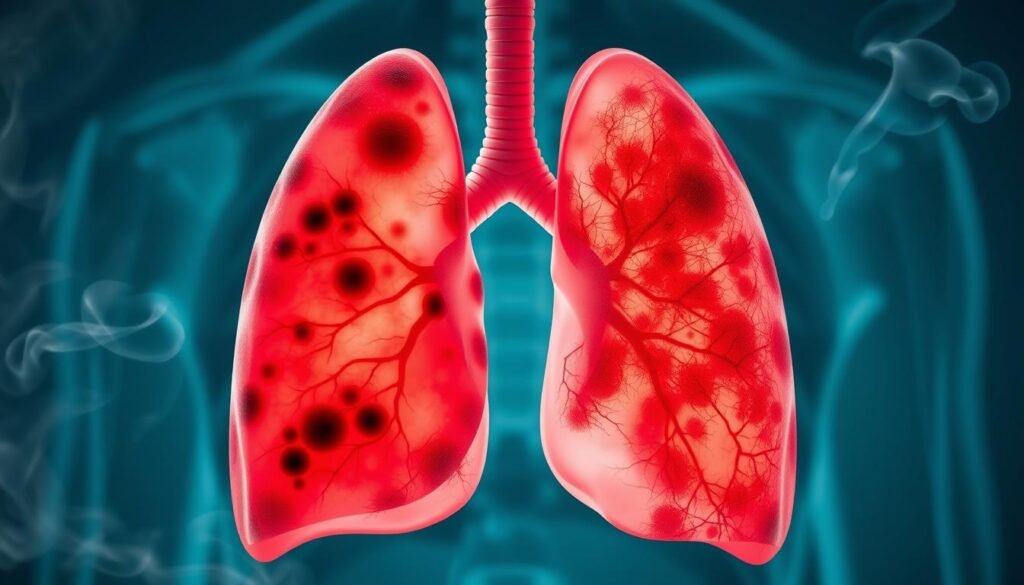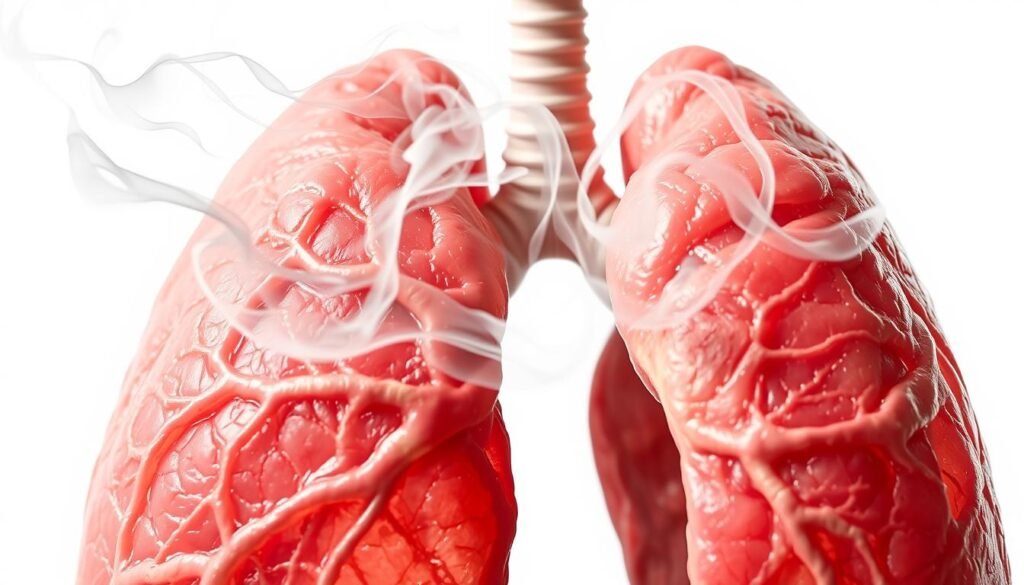Lung cancer is the second most common cancer in the US, but it’s the top cause of cancer deaths worldwide. This fact underscores the need to spot lung cancer signs early. Often, symptoms are missed until the disease is far along. Knowing the physical signs of lung cancer is key to effective treatment. Lung cancer symptoms include long-lasting coughs, frequent respiratory infections, and chest pain. People, especially smokers or older adults, should watch their health closely. Catching lung cancer early through vigilance can help start treatment sooner and improve outcomes.
Key Takeaways
- Lung cancer is often diagnosed in advanced stages due to subtle early signs.
- Common symptoms include a chronic cough lasting more than eight weeks and unexplained weight loss.
- Individuals with a heavy smoking history are at increased risk for lung cancer.
- Routine screenings are recommended for early detection of lung cancer.
- Recognizing lung cancer warning signs can lead to timely medical intervention.
- Consulting a doctor at the first signs of concerning symptoms is crucial.
Understanding Lung Cancer
Lung cancer starts in the lungs, mainly affecting its tissue. It can grow into a tumor. This overview underlines the value of knowing the types of lung cancer. These are small cell lung cancer (SCLC) and non-small cell lung cancer (NSCLC). Each type has a different treatment approach. Smoking is the top risk factor. However, non-smokers can get lung cancer too.
Many people don’t notice lung cancer symptoms until the cancer is advanced. Early on, lung cancer might not show symptoms. This makes early screenings and knowing your risk factors crucial. Signs to watch for include a lasting cough, chest pain, and losing weight without trying. These symptoms can be common to other issues, so seeing a doctor early is key to getting a better outcome.
As lung cancer gets worse, it can spread and cause more symptoms like bone pain or swollen lymph nodes. Advanced cancer might lead to issues like Horner syndrome and superior vena cava syndrome. Knowing these signs is important for staying on top of your health. Regular doctor visits and health checks are crucial.
Why Early Detection is Crucial
Finding lung cancer early is very important. Studies show that early detection can greatly improve someone’s chances of surviving lung cancer. If caught early, patients have more treatment choices and usually respond better to treatment.
Only about 21% of lung cancers are found when they’re still at stage I. This shows we need more awareness about the early signs and how to screen for them. Early detection can lead to better survival rates. People diagnosed early are more likely to live five years or more after being diagnosed than those diagnosed later.
Low-dose CT scans (LDCT) are good for checking for lung cancer early, especially in high-risk people. Groups like the American Cancer Society and the US Preventive Services Task Force suggest people 50 to 80 who have smoked a lot should get screened every year. This can help lower the chance of dying from lung cancer for those who fit the criteria.
It’s also key to notice any changes in your breathing. If something feels off, see a doctor right away to catch any issues early. Even if LDCT scans make you anxious because of possible false alarms, the benefits of catching cancer early are worth it. They can lead to better ways to manage lung cancer.
| Screening Guidelines | Age Group | Pack-Year History | Recommendation |
|---|---|---|---|
| American Cancer Society | 50-80 years | 20 pack-years | Yearly LDCT screening |
| USPSTF | 50-80 years | 20 pack-years | Annual screening |
| NCCN | 50 years and older | 20 pack-years or more | Annual screening |
| CHEST | 55-77 years | 30 pack-years | Annual screening |
Common Lung Cancer Symptoms
Lung cancer symptoms can be hard to spot early on. Spotting symptoms early is key to getting better treatment results. Knowing the signs helps get medical help sooner, which can improve management success.
The Importance of Recognizing Symptoms Early
Some typical symptoms include a lasting cough, losing weight without trying, and chest pain. Non-small cell lung cancer tends to grow slowly, so symptoms may take time to show. On the other hand, small cell lung cancer shows symptoms that get worse fast. Spotting these signs early can lead to quicker diagnosis. If you notice more chest infections or cough up blood, see a doctor right away.
Consulting a Doctor
If you have symptoms that don’t go away or get worse, seeing a doctor is crucial. A doctor can help figure out why you’re seeing these signs. It’s very important to talk to a doctor if you have any lung cancer symptoms. Getting help early can lead to better treatment choices and outcomes, offering care that fits your specific needs.
Physical Signs of Lung Cancer
Knowing the signs of lung cancer is key to catching it early. There are several symptoms that could hint at lung cancer. These symptoms should make one seek medical help right away.
A New Persistent Cough
A persistent cough could be an early sign of lung cancer. This cough doesn’t go away like common coughs. It’s important to notice any new coughing patterns.
Chest Pain and Discomfort
Chest pain from lung cancer can feel sharp or like a constant ache. It gets worse when you move or breathe deeply. This pain means the cancer might be getting serious. Getting help quickly is crucial.
Coughing Up Blood or Rust-Colored Sputum
Coughing up blood is a serious sign. It may show up as rust-colored spit. This needs fast medical action, as it points to major health concerns.
Unexpected Weight Loss and Loss of Appetite
Weight loss and not wanting to eat can be signs of lung cancer. These signs suggest your body is fighting something serious. Don’t ignore these changes.

Signs of Lung Cancer in Females
It’s important to know the signs of lung cancer in females. They can be different from those in males. Sometimes, these signs are not obvious, causing delays in getting help. Early recognition is key to starting treatment sooner.
Unique Symptoms and Risks in Women
Women may show different lung cancer signs. Studies have found these often include:
- Fatigue: A common early sign, but usually overlooked.
- Shortness of Breath: Happens even with light activities.
- Coughing Up Blood: Seen in about 21% of cases.
About 20% of women with lung cancer have never smoked. A study in 2019 found that 70% of young women with the disease were non-smokers. This suggests genetics or the environment might play a big role.
Lung Cancer Risk Factors
Females face both common and unique lung cancer risks. Some of these include:
| Risk Factor | Impact |
|---|---|
| Cigarette Smoking | Strongly linked to more lung cancer in females. |
| Secondhand Smoke Exposure | Increases risk, especially for non-smokers. |
| Asbestos Exposure | Can lead to lung cancer and other diseases. |
| Genetic Predisposition | Some genes can make lung cancer more likely. |
| Poor Diet | Bad eating habits can raise the risk. |
Researchers are looking into why lung cancer affects women differently. Knowing the risks is very important. Staying informed helps us fight lung cancer better.
Specific Symptoms for Non-Small Cell Lung Cancer
Knowing the signs of non-small cell lung cancer (NSCLC) is key for good care. NSCLC can show many symptoms that impact daily life a lot. Spotting these signs early can lead to quick help and possibly better health results.
Common Symptoms and their Impact
Many people with NSCLC have these common symptoms:
- Chronic cough: Around 65.0% of people notice this as the first sign.
- Hemoptysis: About 33.0% might cough up blood, which is urgent.
- Chest pain: 17.9% feel pain, mostly when taking deep breaths, pointing to serious illness.
- Shortness of breath: This affects nearly 17.0% and gets worse over time.
These non-small cell lung cancer symptoms are signs of a possible serious problem. They can make life harder for people, affecting both body and mind.
Potential Complications
The issues NSCLC can cause are major and include:
- Metastasis: The cancer can move to other parts, causing more pain and troubles.
- Lymphadenopathy: This means bigger lymph nodes in the neck and above the collarbone, often in nonsquamous cancer types.
- Advanced stage symptoms: People with stage IV NSCLC usually report more chest pain, weight loss, and tiredness, among other tough signs.
Watching out for NSCLC complications is crucial. Staying in touch with a doctor and noting any new symptoms is important. For more help and info on dealing with NSCLC, there are many resources online, like careyourlungs.com.
https://www.youtube.com/watch?v=ihCnDjyJv5c
Specific Symptoms for Small Cell Lung Cancer
Small cell lung cancer (SCLC) has unique features that make it different from other lung cancers. Knowing these features helps spot the early signs of this fast-moving cancer. The symptoms of SCLC appear quickly, so it’s crucial to understand their progression.
Characteristics of Small Cell Lung Cancer
Small cell lung cancer makes up about 15% of all lung cancer cases. It usually affects men more than women. Smoking is the main cause of SCLC, which is rare in those who don’t smoke. SCLC is very aggressive and often spreads to important organs like the brain and liver fast. Unfortunately, this means most patients have a tough battle, with fewer than 15% living more than five years after they find out they have it.
Progression of Symptoms
Early detection of SCLC symptoms can improve treatment success. Initial symptoms may be:
- Chronic cough
- Chest pain or discomfort
- Weakness and discomfort in daily tasks
As the cancer grows, symptoms usually get worse, leading to:
- Big increases in tiredness
- Neurological issues like headaches or dizziness
- Major breathing problems
When you see late-stage symptoms, it means the cancer has spread a lot. This needs fast medical help. Doctors use tests like chest X-rays and CT scans to see how far the cancer has gone and figure out the best treatment.
| Stage | Common Symptoms | Diagnosis Methods |
|---|---|---|
| Early Stage | Chronic cough, chest pain | Chest X-ray, CT scan |
| Advanced Stage | Fatigue, neurological changes | Bone scans, MRI scans |
Understanding Lung Cancer Cough
A cough linked to lung cancer is often more serious than a typical cold. If a cough lasts more than eight weeks, it could point to lung cancer. About half of the people with early lung cancer have a cough at first.
Nearly 57% of lung cancer patients report coughing, especially in later stages, a 2017 study found. A lung cancer cough can vary a lot. Some patients may have a dry cough or even cough up blood.
It’s important to understand these symptoms. While other conditions like postnasal drip or asthma can cause chronic coughs, it’s crucial to tell them apart from a lung cancer cough. This can lead to faster diagnosis and treatment.
Other worrying signs often accompany a lung cancer cough. These include weight loss, fatigue, and chest pain. Only a small number of patients cough up blood early on. Yet, most acute coughs come from infections not cancer.
Treating a lung cancer cough might require different approaches. These include medicines, chemotherapy, and radiation. Right management is key for comfort and better health outcomes. People should seek medical advice early on for an effective treatment plan.
Knowing about lung cancer cough can lead to timely medical help. For more details, check the resources on lung cancer cough.

Lung Cancer Back Pain: What You Should Know
Back pain can be a big worry for people with lung cancer. Understanding how lung cancer and back pain are linked is key for spotting advanced lung cancer signs early. If you’re having back pain that doesn’t go away or can’t be explained, it could be a warning sign of this disease.
When Back Pain Indicates Serious Issues
About 6% to 25% of lung cancer patients report early bone pain, often in the spine. For those with lung cancer that has spread, around 40% will see it reach their bones, hitting the spine and big bones in the legs. This can lead to major problems like malignant spinal cord compression, a medical emergency that may cause leg weakness or even loss of bladder and bowel control.
It’s very important for lung cancer patients to watch for new or worse back pain. This could indicate serious issues, especially if it comes with sharp pain, numbness, or weakness.
Connection to Advanced Lung Cancer
In advanced stages, back pain and lung cancer are often connected. The pain may come from a tumor pressing on the spine or the cancer moving to the bones. High calcium levels caused by the cancer can also lead to back pain, along with nausea and weakness. Back pain and lung cancer go hand in hand in about 25% of cases, underlining the importance of regular health checks.
It’s crucial for those affected to seek expert medical advice. This ensures they get the care and treatments that suit their specific needs.
Common Infections Related to Lung Cancer
People with lung cancer often face a higher risk of getting common infections lung cancer. Pneumonia is a big worry among these. Pneumonia and lung cancer can look similar because both can cause coughing and breathing trouble. Bronchitis is another infection that can happen, especially in those with weak immune systems.
Recurring Pneumonia or Bronchitis
Pneumonia happens often in lung cancer patients because their bodies are weaker. It’s key to watch out for symptoms of worsening breathing problems. Signs to look out for include:
- Persistent cough that gets worse
- Fever and chills
- Discomfort in the chest when breathing
- Feeling more tired and weak
Having both pneumonia and lung cancer is serious and raises the risk of more health problems. It’s very important to get checked by a doctor early to control these infections. This helps prevent other health issues.
Wheezing and Shortness of Breath
Wheezing in lung cancer patients usually means the lungs aren’t working well. This happens because of swelling and fluid blocking the breathing paths. Knowing these signs is key to keeping the lungs as healthy as possible. People might notice:
- Hard to breathe during daily tasks
- More wheezing when moving around
- Sudden shortness of breath
Understanding these symptoms and managing them early helps keep the lungs working better. Going to the doctor regularly and catching pneumonia or bronchitis early improves health. Knowing the signs that overlap also helps get treatment sooner. For more tips on dealing with lung cancer complications, check out this useful link.
The Role of Paraneoplastic Syndromes
Paraneoplastic syndromes are indirect effects of lung cancer that greatly affect health. They might show up even before the cancer spreads. This makes diagnosing and treating the cancer more complex. It’s critical to know the symptoms early for quick action.
How Paraneoplastic Syndromes Present
About 10% of people with lung cancer will experience paraneoplastic syndromes. These can include endocrine issues or neurological problems. For example, hypercalcemia, which is a high calcium level, shows up in 2% to 6% at diagnosis. It may increase to 8% to 12% over time.
This condition is more common in squamous cell carcinoma patients. It can cause muscle weakness and confusion.
Warning Signs Associated with these Syndromes
It’s vital to recognize lung cancer’s warning signs related to paraneoplastic syndromes. These signs help improve patient outcomes. Symptoms to watch for include:
- Neurological changes like confusion or altered mental state
- Severe weakness or fatigue
- Endocrine problems such as abnormal electrolyte levels
Conditions like SIADH occur in 10% to 45% of small cell lung cancer cases. This shows the potential complexity of symptoms. The ectopic ACTH secretion is proof of the deep connection between lung cancer and its paraneoplastic effects. Spotting these signs early can make treatment more effective.
When to Seek Medical Advice
Knowing when to visit a doctor is key for lung health. Most lung cancers show no symptoms until they spread. However, some people spot early signs of lung cancer. Acting quickly on these symptoms can improve outcomes.
Recognizing Urgent Symptoms
Being aware of critical signs that need quick doctor visits is important. Urgent lung cancer symptoms include:
- A persistent cough that gets worse
- Coughing up blood or rust-colored spit
- Chest pain that grows worse with deep breaths
- Unexpected weight loss and appetite loss
- Feeling short of breath and very tired
- Having a hoarse voice
- Getting infections like bronchitis or pneumonia often
If you have these symptoms, it’s time to see a doctor.
Importance of Regular Check-Ups
For those at high risk, like smokers or those exposed to harmful substances, regular lung cancer checks are crucial. These check-ups can find problems early. This can lead to prompt treatment. The sooner lung cancer is found, the better the chance for successful treatment.

Conclusion
It’s key to know the early warning signs of lung cancer. This knowledge helps in catching the disease early. Early action can lead to better outcomes. Lung cancer is the top cancer killer in the US. So, understanding its symptoms is powerful.
Educating people about lung cancer is critical. Teaching communities about its risks and signs can improve survival. Programs that spread awareness help people. They encourage healthy living and regular doctor visits, especially for those at higher risk.
To beat lung cancer, awareness and action are important. Sharing what we know and promoting education can help a lot. This way, we can detect it sooner and offer treatment. Early action can save lives.